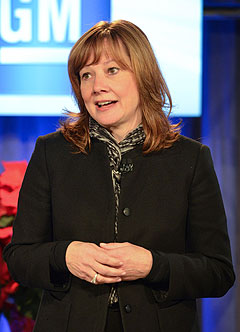GM commits to Holden design, adjusts its role
BY MIKE COSTELLO | 4th Apr 2014

Speaking this week at a design forum hosted by Holden, Melbourne-based GM vice-president of international design Mike Simcoe said Ms Barra shored up the future of the Australian facility after talks with global design boss Ed Welburn last year, when she was head of product development.
“The commitment (to the Australian design studio) now is through Mary Barra – this studio stays alive,” said Mr Simcoe, who added that the decision was a result of the quality of Australia’s work.
Holden says the cost premium that makes car production unviable here does not apply to design.
However, Mr Simcoe revealed that a consequence of Holden’s decision to close its manufacturing operations, as well as end large-scale vehicle engineering, means Port Melbourne will no longer be a “primary studio” that leads the creation of a GM vehicle (such as the Commodore) from sketch all the way through to a road car.
“We won’t do a production vehicle all the way through anymore that is the consequence of the manufacturing and engineering largely being shut down,” Mr Simcoe told GoAuto this week, meaning the final stages of a design brief destined for the road would be completed elsewhere.

But Holden’s experienced design arm – which is one of the most senior of GM’s 10 global studios, and one of only two that fabricates full-scale cars in-house – will continue working on a range of other tasks, from the creation of top-secret internal GM evaluation prototypes to full-on motor show concept cars for overseas events.
It will also continue to play a mentoring role with less-developed studios in places such as India.
This role was evidenced by the Adra SUV revealed at the Delhi motor show earlier this year, a vehicle that was pitched by GM India but required Australia’s greater experience to bring it up to its current status as a motor show concept car.
Furthermore, Holden’s design centre will also continue to participate in so-called “sketch blitzes” in which various GM design studios contribute ideas and concepts to a project being led from the US, Germany or Asia, and lend a hand in areas where it has spare resources, such as providing digital surfacing work.
The Port Melbourne studio is understood to have contributed theme work – principally sketches and renderings – to every configuration of GM vehicle over the past four years. Most brands within the group, from Chevrolet to Buick and Cadillac, have benefited.
But it is the development of internal prototype vehicles that arguably gives Holden design the biggest impact within the GM world. These vehicles are full-scale mock-ups that fit a brief for a future product either pitched by a studio, or handed down from head office to the studio.
We saw one such vehicle this week, which appeared to be a Chevrolet small car. It is understood the vehicle will be flown to the US in a little over a month to be evaluated, and potentially allocated elsewhere for the final stages.
But this car, like the many other internal concepts, will never be seen by the public in its current form, if at all.
Mr Simcoe told us that the local operation functioned “a bit like an agency” in the way it pitched ideas to Mr Welburn at the GM “mothership” in Detroit.
“We’ll start with a simple sales pitch with a few images, and if he (Welburn) agrees that it will work (has road-going potential) we’ll take it further,” he said.
However, unlike when Holden could create its own locally made cars such as the Commodore, Monaro and Cruze hatchback, the Australian studio will “handball” an almost-completed brief to another studio to do the final work on taking a concept design through to production reality.
“The primary studio, be it in the US or Germany, Korea or Brazil, will set up a sketch design blitz around the world (for) anyone who can participate,” said Mr Simcoe.
“The designers will, against the brief, create sketches and create alternatives, then get viewed.
“If we won the blitz or concept competition, we’d take it to a certain point but then hand it to the primary studio to execute.
“We won’t be a primary studio for doing production vehicles. Do we have an influence on road vehicles and themes? Yes. And we still need substantial engineering input to keep that happening.” Holden will retain an unspecified number of in-house engineers after 2017, but is closing down its engineering centre and proving ground.
It also said at the closure announcement last December that it would look to use outside firms for local suspension calibration work.